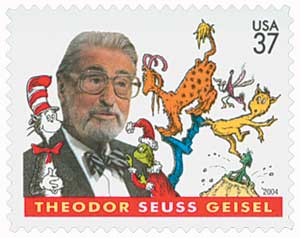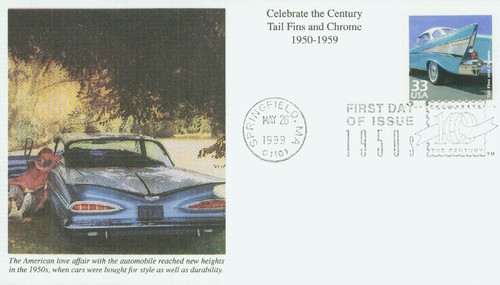
# 3187h - 1999 33c Celebrate the Century - 1950s: Dr. Suess' Cat in the Hat
33¢ Dr. Seuss’ “Cat in the Hat”
Celebrate the Century – 1950s
City: Springfield, MA
Printing Method: Lithographed, engraved
Perforations: 11.5
Color: Multicolored
Happy Birthday Dr. Seuss!
The son of a brew master, Geisel took art classes and managed his school’s soccer team before attending Dartmouth College. While at Dartmouth, Geisel wrote for the school’s humor magazine, Dartmouth Jack-O-Lantern.
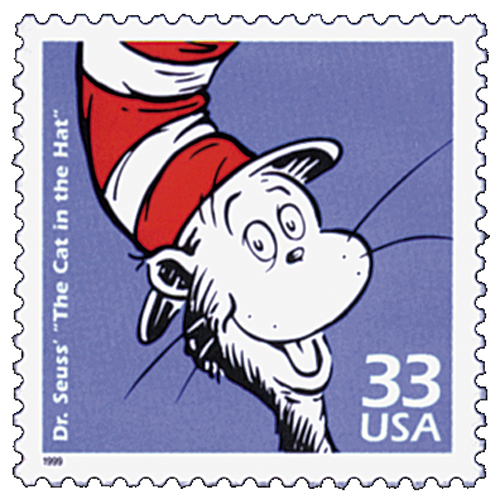
However, Geisel was caught drinking gin in his room with friends during prohibition and had to resign from the magazine as punishment. He continued to write, but signed his work “Seuss,” so the Dean wouldn’t know. After graduation, he used the name “Dr. Theophrastus Seuss,” then shortened it to Dr. Seuss.
Seuss was studying for a Doctor of Philosophy degree at Oxford, England, when a classmate looked at his notes from English class and commented he seemed to enjoy making cartoons more than learning about English Literature. Seuss soon quit school, married his classmate Helen Palmer, and moved back to the United States to do what he loved.
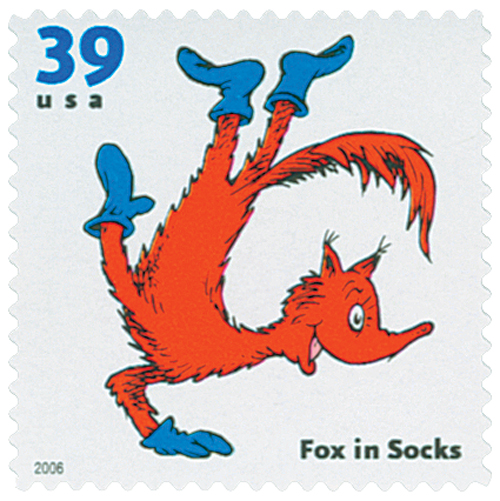
Back in America, Seuss submitted his writing and drawings to magazines, book publishers, and advertising companies. He had his first major success in July 1927 – his first national cartoon in The Saturday Evening Post. Later that year Seuss got a job as a writer and illustrator for the comedic magazine Judge. His work there led to a profitable career in advertising that made him famous for his “Flit” insecticide ads. His phrase, “Quick, Henry, the Flit!” became a popular expression at the time. During the Depression, Seuss also drew advertisements for General Electric, Ford, and NBC.
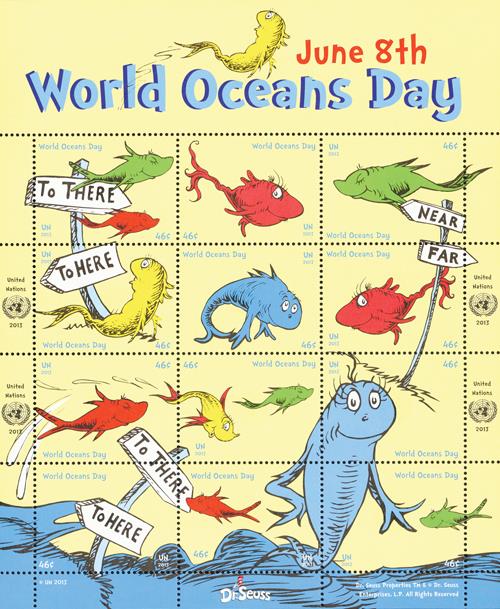
During a trip to Europe in 1936, Seuss was inspired to write a poem that became his first book – And to Think That I Saw It on Mulberry Street. In the years leading up to World War II, Seuss wrote four more books and worked extensively on advertisements, booklets, shows, and even a play for Essomarine motorboat lubricant.
During World War II Seuss created more than 400 political cartoons over the course of two years. He then designed posters for the Treasury Department and War Production Board before joining the Army and serving as commander of the Animation Department of the First Motion Picture Unit. In that role he wrote several films, including one that won an Academy Award.
After the war, Seuss went back to writing children’s books. In 1954, William Spaulding, the director of the education division at Houghton Mifflin publishing, sent a list of 348 words a first-grader should know to Seuss and challenged him to “bring back a book children can’t put down.” After much frustration, he decided that the first two words from the list that rhymed would be the title of the book. That is how The Cat in the Hat was born.
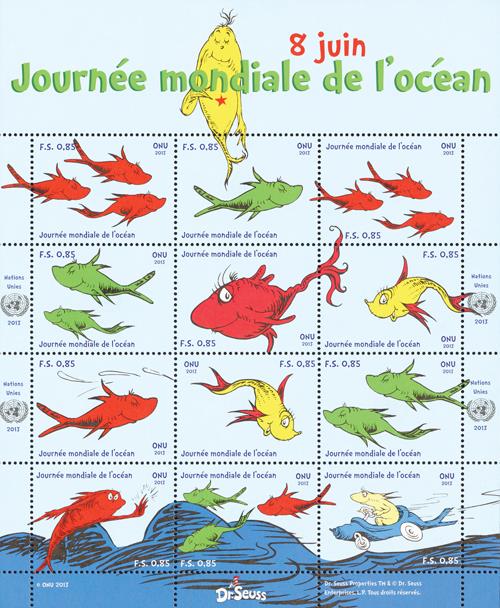
As Dr. Seuss struggled with the verse, he made sketches of the Cat. He wanted a sly troublemaker who wouldn’t strike readers as mean. Seuss combined fanciful illustrations with simple, clever verse to describe the character’s fantastic personality. The Cat became the best-known animal in the Dr. Seuss menagerie.
The Cat in the Hat sold out in bookstores across the country as soon as it was released in 1957. It became a national sensation, with nearly a million copies sold within three years. Editions were available in French, Chinese, Swedish, and Braille. As a result of the success of The Cat in the Hat, Dr. Seuss started Beginner Books, a publishing house for children’s stories.
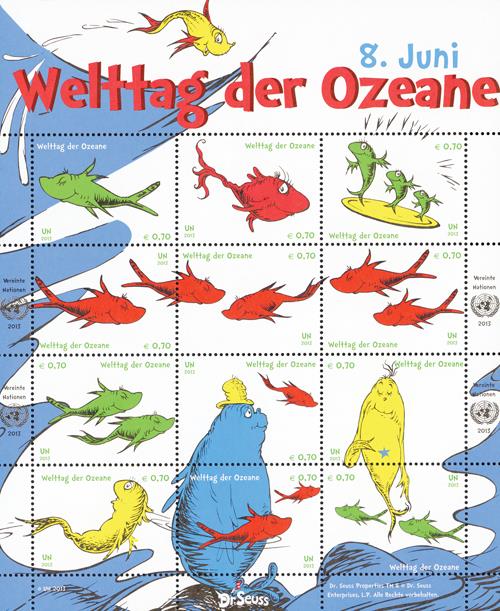
Seuss went on to create some of America’s most popular children’s books, including Horton Hears a Who!, How the Grinch Stole Christmas!, Green Eggs and Ham, and One Fish Two Fish Red Fish Blue Fish. For his accomplishment’s he received an honorary doctorate from Dartmouth in 1956. He later received a special Pulitzer Prize for his “contribution [of] over nearly half a century to the education and enjoyment of America’s children and their parents.” Seuss died on September 24, 1991. Over the course of his life he wrote more than 60 books and sold over 222 million copies. His birthday has since come to be celebrated as Read Across America Day.
Click here for a listing of Seuss’ books, films, and more.
33¢ Dr. Seuss’ “Cat in the Hat”
Celebrate the Century – 1950s
City: Springfield, MA
Printing Method: Lithographed, engraved
Perforations: 11.5
Color: Multicolored
Happy Birthday Dr. Seuss!
The son of a brew master, Geisel took art classes and managed his school’s soccer team before attending Dartmouth College. While at Dartmouth, Geisel wrote for the school’s humor magazine, Dartmouth Jack-O-Lantern.

However, Geisel was caught drinking gin in his room with friends during prohibition and had to resign from the magazine as punishment. He continued to write, but signed his work “Seuss,” so the Dean wouldn’t know. After graduation, he used the name “Dr. Theophrastus Seuss,” then shortened it to Dr. Seuss.
Seuss was studying for a Doctor of Philosophy degree at Oxford, England, when a classmate looked at his notes from English class and commented he seemed to enjoy making cartoons more than learning about English Literature. Seuss soon quit school, married his classmate Helen Palmer, and moved back to the United States to do what he loved.

Back in America, Seuss submitted his writing and drawings to magazines, book publishers, and advertising companies. He had his first major success in July 1927 – his first national cartoon in The Saturday Evening Post. Later that year Seuss got a job as a writer and illustrator for the comedic magazine Judge. His work there led to a profitable career in advertising that made him famous for his “Flit” insecticide ads. His phrase, “Quick, Henry, the Flit!” became a popular expression at the time. During the Depression, Seuss also drew advertisements for General Electric, Ford, and NBC.

During a trip to Europe in 1936, Seuss was inspired to write a poem that became his first book – And to Think That I Saw It on Mulberry Street. In the years leading up to World War II, Seuss wrote four more books and worked extensively on advertisements, booklets, shows, and even a play for Essomarine motorboat lubricant.
During World War II Seuss created more than 400 political cartoons over the course of two years. He then designed posters for the Treasury Department and War Production Board before joining the Army and serving as commander of the Animation Department of the First Motion Picture Unit. In that role he wrote several films, including one that won an Academy Award.
After the war, Seuss went back to writing children’s books. In 1954, William Spaulding, the director of the education division at Houghton Mifflin publishing, sent a list of 348 words a first-grader should know to Seuss and challenged him to “bring back a book children can’t put down.” After much frustration, he decided that the first two words from the list that rhymed would be the title of the book. That is how The Cat in the Hat was born.

As Dr. Seuss struggled with the verse, he made sketches of the Cat. He wanted a sly troublemaker who wouldn’t strike readers as mean. Seuss combined fanciful illustrations with simple, clever verse to describe the character’s fantastic personality. The Cat became the best-known animal in the Dr. Seuss menagerie.
The Cat in the Hat sold out in bookstores across the country as soon as it was released in 1957. It became a national sensation, with nearly a million copies sold within three years. Editions were available in French, Chinese, Swedish, and Braille. As a result of the success of The Cat in the Hat, Dr. Seuss started Beginner Books, a publishing house for children’s stories.

Seuss went on to create some of America’s most popular children’s books, including Horton Hears a Who!, How the Grinch Stole Christmas!, Green Eggs and Ham, and One Fish Two Fish Red Fish Blue Fish. For his accomplishment’s he received an honorary doctorate from Dartmouth in 1956. He later received a special Pulitzer Prize for his “contribution [of] over nearly half a century to the education and enjoyment of America’s children and their parents.” Seuss died on September 24, 1991. Over the course of his life he wrote more than 60 books and sold over 222 million copies. His birthday has since come to be celebrated as Read Across America Day.
Click here for a listing of Seuss’ books, films, and more.






